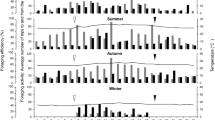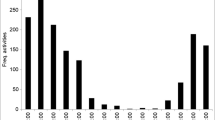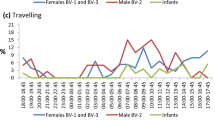Abstract
Daily foraging activity ofAnacanthotermes vagans was tested using toilet paper rolls as bait. The highest activity was recorded at midnight and during the hours of the early morning in both summer and winter seasons. In spring the time of highest activity was reversed to take place at midday, afternoon and early evening. Aktograph records in the laboratory demonstrated that individual workers are active most of the day and not naturally entrianed by photoperiods. Daily activity of groups of 10 workers was not statistically different from that of individual workers.
Similar content being viewed by others
References
Andrews EA, Middleton AR (1911) Circadian activity of nasutes. Circ Johns Hopkins Univ 2:26–34
Applin DG, Clodsley-Thompson JL, Constentinou C (1987) Molecular and physiological mechanisms in chronobiology—their manifestation in desert ecosystem. J Arid Environ 13:187–197
Bodot P (1967) Cycles saisonniers d' activité collective des termites des savanes de Basse cote-d'Ivoire. Insectes Sociaux 14:359–388
Bouillon A (1964) In: Etudes sur les termites africaines. UNESCO, Leopoldville
Collins NM (1981) The role of termites in the decomposition of wood and leaf litter in the southern Guinea savannah of Nigeria. Oecologia 51:389–399
Constantinou C (1980) Entrainment of the circadian rhythm of activity in desert and forest inhabiting scorptions. J Arid Environ 3:133–139
Howse PE (1970) Termites: A study in social behaviour. Hutchimson University Library, London
Khogali HS (1983) On the feeding and foraging activity ofOdontotermes sp. andMicrotermes spp. in two different localities in Central Sudan. Thesis, University of Khartoum, Sudan
Moore D, Rankin MA (1985) Circadian locomotory rhythms in individual honeybees. Physiol Entomol 10:191–197
Nutting WL (1979) Termite flight periods: Strategies for predator avoidance. Sociobiology 4:141–151
Omo Malaka SL, Leuthold RH (1986) Mechanisms of recruitment for the retrieval of food inAmitermes evuncifer Silvestri (Isotera: Termitidae: Termitinae) Insect Sci Applic 7:707–721
Sheppe W (1970) Daily and seasonal patterns of construction activity byOdontotermes latericius (Isoptera: Termitidae). Insectes Sociaux 17:225–232
Su M, Tamashiro M, Yates JR, Haverty MI (1984) Foraging behaviour of the formosan subterranean termite (Isoptera Rhinotermitidae) Environ Entomol 13:1466–1470
Author information
Authors and Affiliations
Rights and permissions
About this article
Cite this article
Absuhama, F.T., Al Houty, W.A. Diurnal activity rhythms of the subterranean termiteAnacanthotermes vagans (Hagen) under laboratory and field conditions of the Kuwait desert. Int J Biometeorol 33, 12–18 (1989). https://doi.org/10.1007/BF01045891
Received:
Revised:
Issue Date:
DOI: https://doi.org/10.1007/BF01045891




